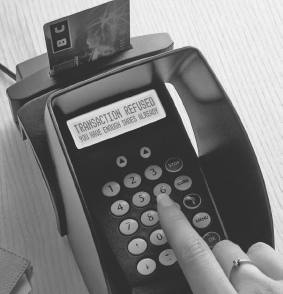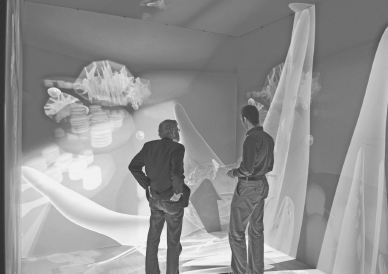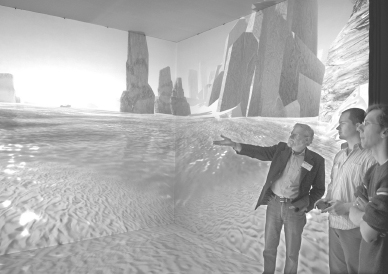The Design of Future Things (21 page)
Read The Design of Future Things Online
Authors: Don Norman
As we move forward, society needs to address the impact of all this change on individuals and societies. Designers are at the forefront of these concerns, for it is the designer who translates ideas into reality. Today, more than ever before, designers need to understand the social impact of their actions.
Science Finds,
Industry Applies,
Man Conforms
âMotto of the 1933 Chicago World's Fair.
People Propose,
Science Studies,
Technology Conforms
âA person-centered motto for the twenty-first century.
In my book
Things That Make Us Smart
, I argue that it is technology that should conform to us, not, as the 1933 World's Fair motto would have it, we who should conform to technology. I wrote that book in 1993, and since then I have changed my mind. Sure, I would prefer that machines adapt to people. In the end, though, machines are simply too limited in capability. We humans are flexible and adaptable. They are rigid and unchanging. We are more capable of change. We either take technology as it is or go without.
The danger of stating that people must adapt to machines is that some designers and engineers will interpret the recommendation out of context, believing it gives them free rein to design however they wish, optimizing their work for machine efficiency and ease of design, engineering, and construction. But the statement is not an excuse for inappropriate design. We certainly shouldn't have to adapt to that.
We need the best designs possible, ones that are sensitive to people, that follow all the best rules of human-centered,
activity-centered design, designs that follow the rules put forth within this book (summarized in
chapter 6
,
page 152
). Even in the best of cases, however, when the best designers have done the best jobs possible, the machines will still be limited. They will still be inflexible, rigid, and demanding. Their sensors will be limited, their capabilities different from ours. And then there is that huge gulf of common ground.
Who would have thought that we would have to explain ourselves to our machines? Well, we do. We have to explain to our automobile that we really want to turn left. The day will come when we have to tell the vacuum cleaner that we don't want it to clean the living room right now, thank you. We may have to inform our kitchens that, please, we are hungry now, and we would like to eat, and tell our music players that we are going out for a run, so would it pick music appropriate to our pace.
It helps if the machines know what we intend to do, just as it helps if we know what they intend. Once again, though, because machine intelligence is so limited, the burden lies with us. These adaptations will end up benefiting all of us, just as making a home or place of business accessible to those with handicaps turns out to be useful for everyone.
It's important to keep in mind that adapting to technology is hardly a new phenomenon. From the first tools onward, the introduction of each has changed the way we behave. In the 1800s, we paved roads for carts and vehicles. In the 1900s, we wired our homes when electricity replaced gas lines, added pipes once plumbing and toilets came indoors, and installed wires and outlets for telephones, television sets, then internet connections. In the 2000s, we will redo our homes for the benefit of our machines.
Coincidentally, in the 2000s many nations face an aging population. People will discover that they must restructure their homes and buildings to accommodate their elderly relativesâor themselves. They may have to add elevators, provide entrance ramps, replace knobs with levers on faucets and doors, and enlarge doorways to allow the passage of wheelchairs. Light switches and electrical outlets will be moved for easier access; the height of kitchen counters, sinks, and tables will have to be
adjusted. Ironically, these are the very same changes that will make life easier for machines, even as we bring in those machines to make life easier for the elderly. Why? Because machines share with the elderly similar limitations in mobility, agility, and vision.

F
IGURE
7.2
“Transaction refused: You have enough shoes.” This figure, by the Belgium advertising agency Duval Guillaume Antwerp, hints at the future of intelligent technology. Actually, the store's credit card terminal would want to encourage you to buy matching socks, belts, or shirts, but your personal assistant might very well try to stop you. So now, not only do we have intelligent systems offering advice, but we might have fights and conflicts.
(Photograph and permission to reproduce provided by the
photographer, Kris Van Beek,
www.krisvanbeek.com
)
Will we reach the day of dueling intelligences: Your refrigerator enticing you to eat while your scale insists you shouldn't? The store enticing you to buy, but the personal assistant inside your mobile phone resisting? Even your television and cell phone might gang up on you. But we can fight back. The personal advisor of the future will look out for you, perhaps residing inside the very same television or telephone that is trying to sell you that other pair of shoes. “No,” says one helpful machine (
Figure 7.2
), “transaction refused: you have enough shoes.” “Yes,” says another machine, “you need new shoes for the formal dinner next week.”
Design: The deliberate shaping of the environment in ways that satisfy individual and societal needs.
Design cuts across all disciplines, be it the arts or sciences, humanities or engineering, law or business. In universities, the practical is often judged less valuable than the abstract and theoretical. Universities, moreover, put each discipline into separate schools and departments, where people mainly talk to others within their own narrowly defined categories. This compartmentalization is optimal for developing specialists who understand their narrow area in great depth. It is not well suited
for the development of generalists whose work cuts across disciplines. Even when the university tries to overcome this deficit by establishing new, multidisciplinary programs, the new program soon becomes its own discipline and grows more and more specialized each year.
Designers must be generalists who can innovate across disciplines. In turn, they must be able to call upon specialists to help develop their designs and to ensure that the components are appropriate and practical. This is a new kind of activity, different from what is normally taught in the academic departments of universities. It is somewhat akin to the way schools of management work. For example, they train managers who must also be generalists, able to understand the many divisions and functions of a company, able to call upon specialists within each area. Perhaps design belongs in the school of business.
Design, today, is taught and practiced as an art form or craft, not as a science with known principles that have been verified through experimentation and that can be used to derive new design approaches. Most design schools today teach through mentoring and apprenticeship. Students and beginning professionals practice their craft in workshops and studios under the watchful eyes of instructors and mentors. This is an excellent way to learn a craft, but not a science.
It is time for a science of design. After all, we know a lot about design from the many related disciplines: the social sciences and the arts, engineering, and business. To date, engineers have attempted to apply formal methods and algorithms that optimize the mechanical and mathematical aspects of a design but tend to ignore the social and the aesthetic. The artistic side,
on the other hand, fiercely resists systematization, believing it will destroy the creative heart of design. However, as we move toward the design of intelligent machines, rigor is absolutely essential. It can't be the cold, objective rigor of the engineer, for this focuses only on what can be measured as opposed to what is important. We need a new approach, one that combines the precision and rigor of business and engineering, the understanding of social interactions, and the aesthetics of the arts.
What does the rise of the smart machine mean for designers? In the past, we had to think about how people would interact with technology. Today, we also need to take the machine's point of view. Smart machines are all about interaction, symbiosis, and cooperation, both with people and with other smart machines. This is a new discipline, with very little past work to guide us, despite the development of fields whose names sound as if they were ideally suited for our needs, fields such as interactive design, supervisory control, automation design, and human-machine interaction. There is enough known about human psychology to make a beginning. The applied fields of human factors and ergonomics have provided many useful studies and techniques. We need to build on these.
The future puts new demands on our designs. In the past, we merely used our products. In the future, we will be in more of a partnership with them as collaborators, bosses, and, in some cases, servants and assistants. More and more, we supervise and oversee, even as we ourselves are being supervised and overseen.
Smart autonomous machines are not the only direction of the future. We will inhabit virtual worlds, where we travel effortlessly through artificially created environments and converse
with the displayed images of avatars, perhaps unable even to distinguish the real from the artificial. Entertainment will change drastically because of the social interaction of people across the world and because of the power of simulations to make us believe we are experiencing new events, new worlds.
Research laboratories are already studying three-dimensional spaces, such as the one shown in
Figure 7.3
, which provides detailed images of dynamic worlds, displayed on the floor, walls, and ceiling of the room. It is an amazing experience, conducive both to education and entertainment. Note, too, that it is a shared experience, as groups of people can explore the environment together. The figure fails to capture the power of the experience. This is a future that is emotionally appealing and engaging as well as educational and entertaining.
We are in for confusing times and exciting times, dangerous times and enjoyable times, for viscerally exciting interactions, behaviorally satisfying ones, and reflectively pleasurable ones. Or perhaps, we are not. How well these will succeed will depend on the design of future things.
Â

F
IGURE
7.3
The entertainment/learning system of the future. These photographs were taken at the Virtual Reality Applications Center at Iowa State University. I am standing inside a “cave,” surrounded by extremely high-definition images in front, behind, on the sides, and on the floor and ceiling. In the top image, I am inside a plant cell, learning biology. In the bottom one, I'm on a beach. This is a multi-million-dollar installation, with one hundred million pixels of displays, and the computers required to drive the images take so much power that special circuits are required, with huge air conditioners to keep them cool. But what is in the laboratory today will be in the home in a decade or two.
(Photographs taken by Brett Schnepf of Microsoft, 2007)
